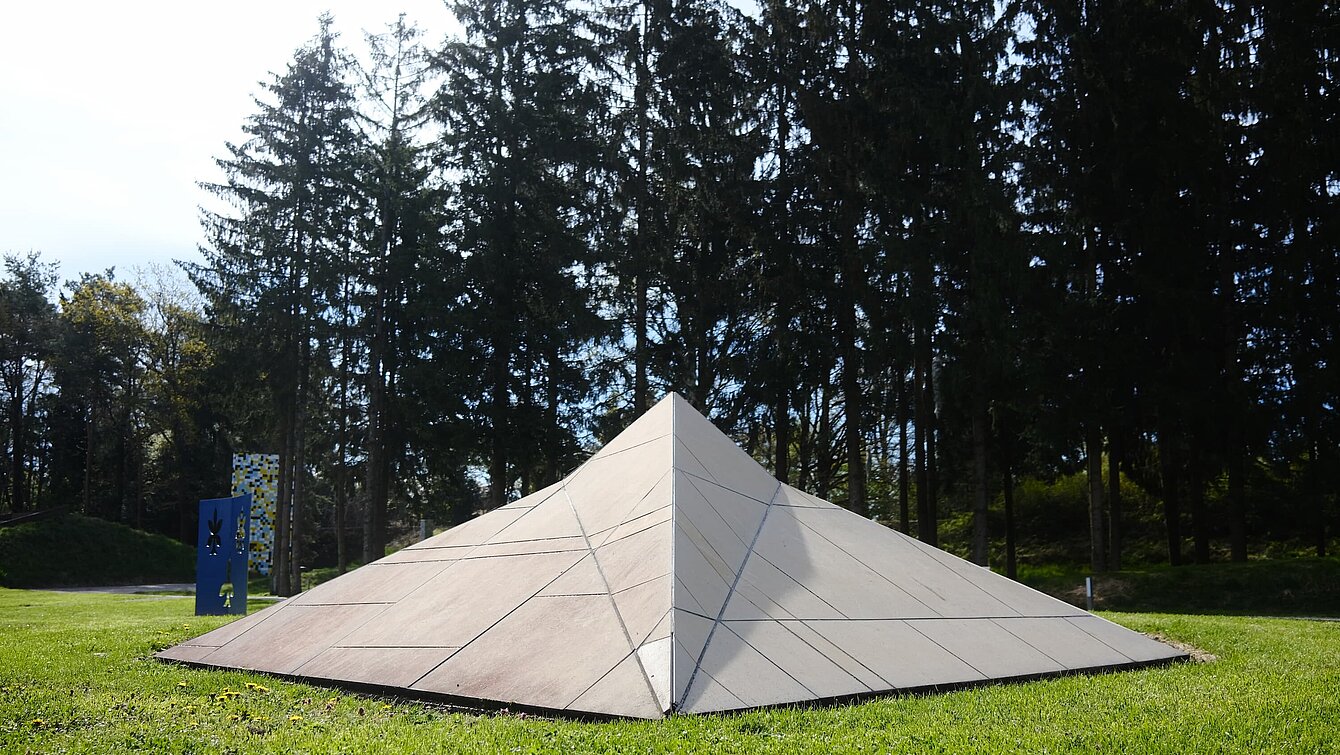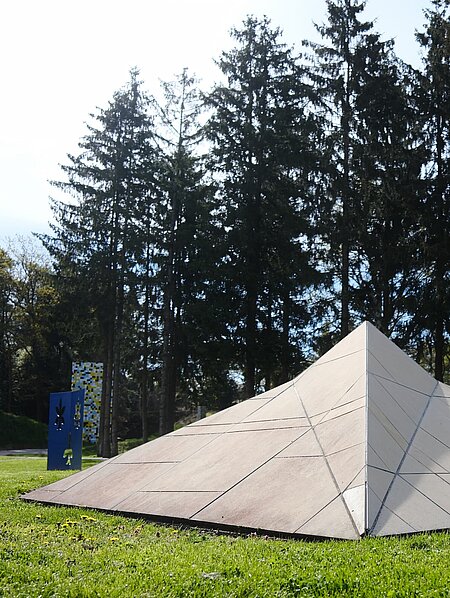Sandbichler’s work was inspired by the spread of misinformation that the Tamil Tigers militant guerrilla group owned a stealth ship. Just like this information, the stealth ship here is also fake, because it is a sculpture. The camouflage function actually works nonetheless, because its shape cannot be detected by any radar. This is irrelevant, however, because revealing or circulating military secrets is the real means by which power is demonstrated. Hence the work presents itself in an ambiguous way— on the one hand, in reversed camouflage, showing the object as a formal aesthetic structure; on the other hand, as the prototype of an underground combat device that has disguised itself as a work of art.
Tiger Stealth (currently not on display)
Peter Sandbichler, 2009


Image Credits
Author
Elisabeth Fiedler
Location on map
Position 60
Owner
Universalmuseum Joanneum
Artist biography
Peter Sandbichler
Show all
About the sculpture
The expansion of the concept of sculpture since the beginning of the 20th century, which, based on the abandonment of anthropomorphic structures, led to the polarity of abstraction and the return of the object, also raises questions regarding the autonomy of material and putting the object into a social context. Materials range from stone to bronze, glass and concrete, from primed objects to prefabricated industrial material, from the application of the basic elements water, air, earth and fire to the own body and essences thereof.
Peter Sandbichler, born in Kufstein in 1964, developed from the end of the 1980s a new language of forms with great interest focusing on social-political questions. This happened on the basis of his knowledge and a classic training as a wood and stone sculptor and after having studied New Media.
Friedrich Kiesler, whose artistic and socio-cultural approach “does not strive for the formation of a hierarchy between the useable, the useful and .... as what is described as artistic“ (Martin Fritz in: Peter Sandbichler, Privat, Living with Sculpture, p. 3, Vienna 2008) is of interest for Sandbichler, since he is not focused on what is auratic or ingenious. On the contrary, he designs his work in consistent feedback to proven systems, images anchored down in collective memory and media storage, frequently including the beholder.
Thus it is about selected objects trouvés keeping each other hovering by mere drag and compressive forces according to the system by Buckminster Fuller and Kenneth Snelson in Tensegrities, and about the fathoming of connective variables and the fragility of systems. It is also about the general adaptation of historical heroes and personalities such as Che Guevara or Anna Politkowskaja, whom he reflects in the form of omnipresent media; it is about publicity and privacy, universality and individual meaning, about the whole and the fragmentation of form and meaning as well as the absorbtion of and interaction with his sculpture by the audience.
Independent of whether Sandbichler embosses metal in sculptural tradition, archives, or works with concrete or material he found or light – the results would always show as objects that seem flexible in their components or become as pixels both analogically and digitally readable. Peter Sandbichler draws basic structures also in the form of tilings, i.e. two-dimensional basic elements he would turn into three-dimensional sculptures in order to show architectural structures but also messages with political meaning.
His work Hotel Palestine, 2003, is particularly characteristic of this. Here he reconstructs the modular modernist façade of the hotel, from the front of which all journalists reported during the disaster of the second Iraq war, as a sculpture. In this work, Sandbichler confronts us with a reflection on life and death, media information, denial of reality, veiling and reconstruction of truth, by means of a fragile plastic wall.
By analysing the boundaries between life and art he fosters the pervasion of the mundane with both socio-cultural and political impetus in modular structures, counteracting any kind of hand-written gestures. Sandbichler is much more interested in systems and collaborations from which both formal and content-related new determination of publicity would be striven for. Industrial pre-fab material will be put together in form-giving structures in order to re-refer to political, social, public and private intentions and reflect the influence of media.
Thus Tiger Stealth too, based on a collaboration with knowbotic research results as sculptural necessity to unveil or hawk military secrets in order to be able to demonstrate power. A form that remains invisible from radar confirms the imaginary efficiency of the war tool. At the same time, the paradox that there is a secret weapon but information about it is widely spread, is of paramount importance for the demonstration of power.
Peter Sandbichler says that “knowbotic research” based their complex installation on an announcement on the Internet, according to which the militant Tamil Tigers guerillas in the north of Sri Lanka claimed to own a stealth boat and documented a corresponding manoeuvre in a small-format video. Inspired by this story a fake was staged in the context of the Duisburger Akzente Festival, including this small functioning stealth boat amongst other things. We rebuilt it from a pixel image on the Internet. It really works and is sold via Internet”. (Peter Sandbichler in: Peter Sandbichler, Privat, p. 8)
Concrete requirements like e.g. that no angle must be steeper than 40 degrees in order to remain invisible from radar or the development of an ergonomic shape to also house a person and the simultaneous discovery that the stealth boat does not work, does not eliminate the myth, Sandbichler made visible. It also shows the principle of the design formula “form follows function”, meticulously followed by Sandbichler.
In aesthetic beauty, the latest materiality, glass-fibre reinforced concrete in the modular system, the bomber no longer appears in camouflage but seems to be stranded in artificial landscape architecture.
In a peculiar ambivalence of deception and revelation with regard to its meaning as a military device and after the metamorphosis into sculpture, the work represents itself in double meaning: on the one hand decamouflaged thus presenting the object as an aesthetic structure, on the other hand, the prototype of this underground fighting device sneaked its way into the Austrian Sculpture Park pretending to be a work of art. Thus the safety of the landscape is re-interpreted as uncertain waters thereby shattering our perception of safety and danger, nature and structure.



















